by Fred
Sinfield ©
(click on photos to enlarge image)
A PRESENTATION FROM HIS HIGHNESS
The gilded silver box contained a personal card
informing that the presentation was With Compliments
from His Highness the Maharawat of Partabgarh,
Partabgarh, South Rajputana 1935.
The presenter being His Highness Maharajadhiraj
Maharawat Shri Sir Ram Singh II Bahadur, KCSI, of the
Sisodhyia dynasty born in 1908, ascended to the throne
in 1929 and died in 1949.
on the right: A photograph of His Highness
Maharajadhiraj Maharawat Shri Sir Ram Singh II Bahadur
of Partabgarh, India, the patron and presenter of the
box featuring thewa work of the Raj Sonis in 1935.
|
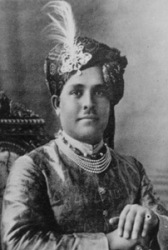 |
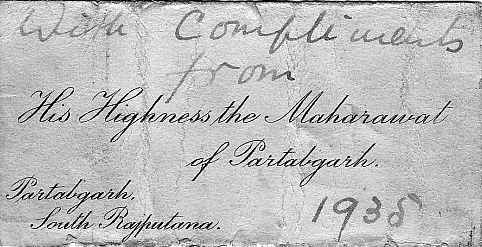 |
The card in the silver box informs that it
was presented With Compliments from His Highness the
Maharawat of Partabgarh, Partabgarh, South Rajputana
1935, possibly to a an ex patriot Civil Service
officer for services rendered.
|
He was the ruler of the small princely state founded in 1433
as Sadri; renamed Partabgarh in 1698 then in 1818 became a
British protectorate and since 1948 part of the state of
Rajasthan, India.
The decoration of the box is different to other types of
embellishments used on box lids and is known as theva or thewa
work that is unique to Partabgarh in the Chittorgarh district of
India. There are differing stories of how this technique was
developed, one is that Nathu Soni invented the process but was
imprisoned when he refused to impart his secret to his ruler or
the goldsmith Nathuni Sonewalla developed the process in the
second quarter of the 18th century.
There is also another story that the technique originated in
Bengal about 400 hundred years ago where it was not received
well so the family of Bengali artisans set off in search of
patronage.
The Maharawat of Pratapgarh gave a land grant and his patronage
to these Hindu artisans so they settled in Rajasthan where they
taught male members of the Soni family, who call themselves 'Raj
Sonis’, the secrets of the craft that passed directly from
father to son over the generations.
The unmarked hinged lidded rectangular box presented by His
Highness depicts a scene of a prince mounted on his steed aiming
his rifle at a lunging big cat whilst another beast watches the
event, set on a green glass background within a cut out border
design.
The box measures 45x35x25mm, gilded externally and internally
and the sides embossed with a continuous floriated design within
a punched border.
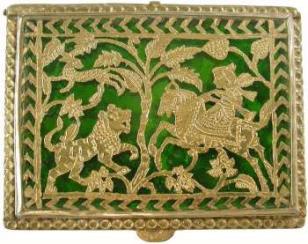 |
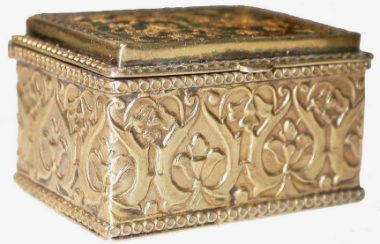 |
The scene on the lid of the hinged lidded
rectangular box; showing a mounted prince aiming a
rifle at a lunging big cat set on a green glass
background within a cut out border design.
|
A close up of the gilded box with the sides
embossed with a continuous floriated design within a
punched border.
|
The presentation of this box was possibly to a Civil Service
officer connected with the "Allocation of Seats under the
Government of India Act, 1935, for the Upper Chamber of the
Federal Legislature for British India".
The other hinged lid container from the collection of and
illustrated in Dr. G. Cummins book is described as a Miniature
Eastern spice box in silver with gold overlaid green glass top.
The three small drawers in the base are probably for expensive
spices such as saffron.
The scene on the lid is set within the same border design as the
other box but features a seated female, a big cat, birds and
floriated designs. The hinged lid does not have a foil backing
used in other versions but relies on the reflection from the
shallow compartment beneath.
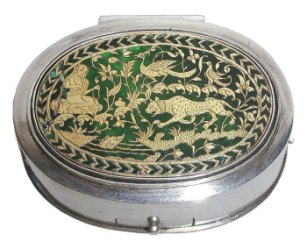 |
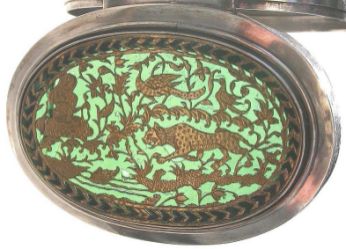 |
The oval hinged lid container from the
collection of Dr. G. Cummins features a seated
female, a big cat, birds and floriated designs
created using the thewa technique.
|
The lid of the oval box back-lighted showing
the details of the gold work on a green glass base.
|
The lid compartment or one of the three draws in the base
could be used to store sindoor, the vermillion paste used by
Indian women to indicate their marital status. In the base, the
central sliding draw is the full depth of the box whilst the
draws on either side in self-contained compartments about the
central draw and there is also a base rim.
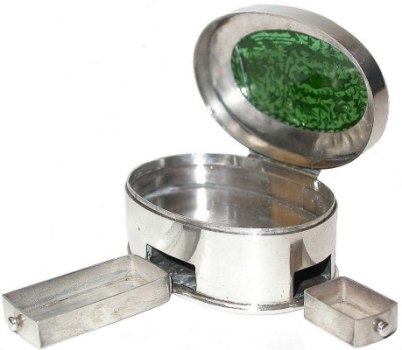 |
In the base of the oval box is a full-length
draw whilst those on either side are in a
self-contained compartment possibly to hold spices
or cosmetics.
|
The solidly constructed oval silver container is 50x25x45mm,
weighs 56grams and is unmarked.
The workmanship on the lid of both pieces is similar but the
oval box has finer detailed gold work, which indicates that this
box predates the rectangular one by some decades. As it is
undated, it could be from the reign of either Udai Singh who was
the Maharawat from 1864 to 1890 or his successor Raghunath Singh
from 1890 to 1929. The former rather than the latter is favoured
due to the quality of the workmanship. The standard of thewa
work had declined by the time of the presentation in 1935 as the
weight of 36.4grams suggests and the finish lacks the fineness
of the oval box. The earlier, heavier and finer finished pieces
are more appealing as the artisans had the time to work on the
creation of each item.
Some of the finest examples of this unique form of decorative
art are in local museum collections in India as well as abroad
including the Metropolitan Museum of Art and the Victoria &
Albert.
Although not often seen on the market outside of India, one
thewa piece was for auction at Donnington Priory in July 2005.
This was A 19th century gold Partabgarh thewa-work necklace,
circa 1860-70, in the form of seven graduated oval green glass
panels inlaid in gold and depicting hunting scenes with horsemen,
and flowers and animals, mounted within alternate polished and
burr-bead borders and with a bell-shaped filigree and beaded
tassel fringe, to a two row woven cable-link back-chain on a
similar thewa-work panel clasp, in a fitted case from 'Phillips
Bros & Son, Art Goldsmiths, 23 Cockspur Street, London', approx.
46cm long overall (18 in). This was memento of Partabgarh,
possibly acquired by an ex patriot or visitor, who took it when
they returned to the UK and sold it to the goldsmith who boxed
it for resale.
The process of making thewa work is detailed; time consuming and
intricate, taking up to a month to complete each piece. It
starts with broken pieces of terracotta, finely ground, mixed
with chemicals and oil to produce a thick paste. The paste
spread on a wooden base has a 23carat gold sheet of 40gauge
thickness set onto the mixture and the free hand design etched
on it. Black paint spread over the gold sheet highlights the
design so it becomes clearly visible for further detailed work
with fine tools. The craftsman removes the excess gold creating
a design often based on Hindu mythology or Mughal court scenes,
historical events or with fauna and flora motifs.
Gentle heating enables the peeling of the gold sheet from the
base, which is a delicate step as the fragile sheet can break or
lose shape; then thoroughly washed and cleaned with a mild acid
solution. A piece of coloured glass traditionally red, green or
blue, acquired from windowpanes of old buildings, is cut to the
same size as the gold pattern and the silver frame and heated.
Pressed onto the surface of the glass while it is still hot are
the silver rim and the film of gold, by gently reheating the
metal and the glass fuse and then allowed to cool slowly. Often
fixed to the base of the glass is a thin piece of silver foil to
give a uniform lustre, which is then encased in a silver bezel
mount to finish the process. There are, however, limitations as
to size of these panels as there is the danger of large pieces
of glass cracking during heating. Over time the glass is liable
to crack as it is fragile when used for this purpose.
Prior independence in 1947, thewa craftsmen
relied on royal commissions but this patronage waned,
so post-independence there was little interest in
this type of luxury items. The practice and
knowledge of the art declined and languished due to
lack of demand but has since had a revival,
especially for jewellery pieces.
on the right: interest waned in thewa work after
Indian independence but has subsequently had a
revival as seen in this modern neck jewel using the
400 hundred-year-old technique
|
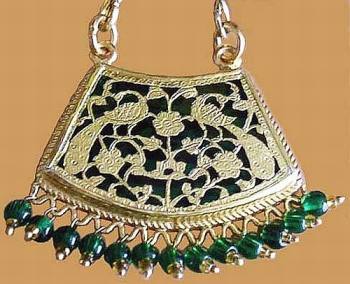 |
Ganpat Soni, a National Award winner and a modern master in
the technique of thewa said that … the work requires intricate
detailing and skilful fusion of the gold into the glass base,
the wastage is high. Overheating can break the glass or melt the
gold. Alternatively, if not treated properly the gold filigree
does not fuse well and soon comes off. The problems are many -
few selling outlets, lack of real appreciation for a thewa
piece, with people often questioning the purity of gold rather
than admiring the intricacy and skill of the designs. Also,
Belgian glass, the base material for a thewa piece is becoming
increasingly difficult to find and new sources are not
forthcoming.
There is increased awareness of thewa work as
Ganpat Soni received enthusiastic responses to
displays and demonstrations of the craft at
international fairs and exhibitions, but regretfully
he added - very few confirmed orders. The variety of
items made using this technique is large and
includes personal items, jewellery, plates, picture
frames, perfume bottles and vases.
on the right: there is increased awareness
internationally of thewa work but unlike other
precious metal items the value of a piece is the
skill and time required to fashion it as seen on the
lid of this modern revival box
|
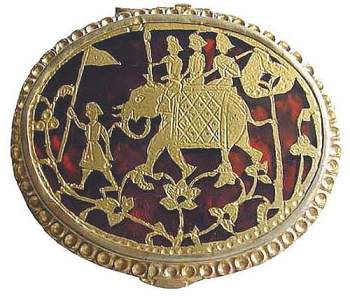 |
Unlike other precious metal items, the value of a thewa
piece is not the intrinsic value but the skill required to
fashion the piece.
Further information is on various web sites that cover the story
of this unique art form of the Sonis of India.
Bibliography
Oppi Untracht. 1997. Traditional Jewelry of India. Thames
& Hudson. London.
Rita Devi Sharma & M Varadarajan, 2004. Handcrafted Indian
Enamel Jewellery. Roli & Janssen, New Delhi.
Dr. G Cummins. 2006. Antique Boxes Inside and Out.
Antique Collectors Club, Woodbridge, Suffolk.
Web site: www.craftrevival.org/Artisans/002594.htm
Fredric Sinfield © - 2007 -
|
|
|
 ASSOCIATION OF SMALL COLLECTORS OF ANTIQUE SILVER
ASSOCIATION OF SMALL COLLECTORS OF ANTIQUE SILVER ASSOCIATION OF SMALL COLLECTORS OF ANTIQUE SILVER
ASSOCIATION OF SMALL COLLECTORS OF ANTIQUE SILVER